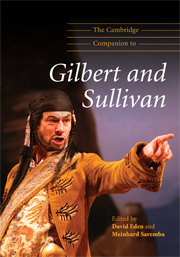Book contents
- Frontmatter
- Part I Background
- 1 Savoy opera and its discontents: the theatrical background to a quarrel
- 2 Identity crisis and the search for English opera: the Savoy Theatre in the 1890s
- 3 Resituating Gilbert and Sullivan: the musical and aesthetic context
- 4 ‘We sing as one individual’? Popular misconceptions of ‘Gilbert and Sullivan’
- Part II Focus
- Part III Reception
- Part IV Into the twenty-first century
- Appendix 1 Who wrote the overtures?
- Appendix 2 Stage and choral works by Arthur Sullivan and W. S. Gilbert
- Appendix 3 Modern editions of works by Arthur Sullivan and W. S. Gilbert
- Appendix 4 Sullivan's archetypes of English opera
- Notes
- Bibliography and further reading
- Index
- Plate section
3 - Resituating Gilbert and Sullivan: the musical and aesthetic context
from Part I - Background
Published online by Cambridge University Press: 28 September 2011
- Frontmatter
- Part I Background
- 1 Savoy opera and its discontents: the theatrical background to a quarrel
- 2 Identity crisis and the search for English opera: the Savoy Theatre in the 1890s
- 3 Resituating Gilbert and Sullivan: the musical and aesthetic context
- 4 ‘We sing as one individual’? Popular misconceptions of ‘Gilbert and Sullivan’
- Part II Focus
- Part III Reception
- Part IV Into the twenty-first century
- Appendix 1 Who wrote the overtures?
- Appendix 2 Stage and choral works by Arthur Sullivan and W. S. Gilbert
- Appendix 3 Modern editions of works by Arthur Sullivan and W. S. Gilbert
- Appendix 4 Sullivan's archetypes of English opera
- Notes
- Bibliography and further reading
- Index
- Plate section
Summary
Arthur Sullivan's operas based on W. S. Gilbert's librettos occupy a strange and to some extent bewildering place in nineteenth-century music. As both an outgrowth of a (so-called) ‘serious’ tradition of operatic culture (as is made witness not only by Sullivan's rigorous training and fluent proficiency in the mainstream tradition of German music but in the numerous allusions to and parodies of this august operatic lineage contained within these works) and at the same time seemingly the predecessors to a less well-regarded line of operettas, musicals and shows, the Savoy operas dwell in a strange no man's land between the serious (respectable) and popular (frivolous). This ambivalence is seen as borne out by that strange and still-present formulation, the double-barrelled, bicephalic entity referred to by all as ‘G & S’, even in contexts when only the music is being expressly referred to. At the same time, and not unrelatedly, these works have been afforded a remarkably polarised reception between enormous popular affection and critical opprobrium. To understand how this reception history has come about and where these works might most profitably be situated it is necessary to investigate more deeply the relationship of these pieces to their musical and aesthetic background, the sources, models and inspiration from which this unique series of operas grew, and to explore the impact such aesthetics might have had for their divided critical reception.
- Type
- Chapter
- Information
- The Cambridge Companion to Gilbert and Sullivan , pp. 36 - 49Publisher: Cambridge University PressPrint publication year: 2009



